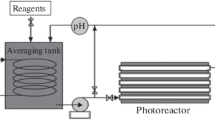Abstract
The kinetic regularities of degradation of the azo dye methyl orange (MO) in photoinitiated oxidizing systems have been studied using a xenon lamp (UV–Vis) as a source of quasi-solar radiation. According to the efficiency and rate of dye destruction, the considered oxidizing systems can be arranged in the following series: {UV–Vis} < {UV–Vis/S2O\(_{8}^{{2 - }}\)} < {S2O\(_{8}^{{2 - }}\)/Fe0} < {UV–Vis/S2O\(_{8}^{{2 - }}\)/Fe0} < {UV–Vis/S2O\(_{8}^{{2 - }}\)/Fe2+}. It has been established that in photoinitiated Fenton-like oxidizing systems there is not only complete conversion of MO but also its deep mineralization in aqueous solution; a decrease in the content of total organic carbon reaches 60%. In this case, the specific catalytic activity of iron ions in the combined system {UV–Vis/S2O\(_{8}^{{2 - }}\)/Fe0} is much higher than in {UV–Vis/S2O\(_{8}^{{2 - }}\)/Fe2+}. Using inhibitors of radical reactions, it has been proved that in the combined system {UV–Vis/S2O\(_{8}^{{2 - }}\)/Fe0} both hydroxyl and sulfate anion radicals take part in oxidative degradation. An inhibitory influence of anions (bicarbonates, chlorides, nitrates, and sulfates) and natural dissolved organic matter (Suwanee River 2R101N) on the process of mineralization of total organic carbon during oxidative destruction of MO in the combined system {UV–Vis/S2O\(_{8}^{{2 - }}\)/Fe0} has been found.






Similar content being viewed by others
REFERENCES
M. Han, H. Wang, W. **, et al., J. Environ. Sci. 128, 181 (2023). https://doi.org/10.1016/j.jes.2022.07.037
L. Li, X. Yuan, Zh. Zhou, et al., J. Clean. Prod. 372, 133420 (2022). https://doi.org/10.1016/j.jclepro.2022.133420
B. Ramos, L. B. Ferreira, P. H. Palharim, et al., Chem. Eng. J. Adv. 14, 100473 (2023). https://doi.org/10.1016/j.ceja.2023.100473
S. Giannakis, S. Samoili, and J. Rodríguez-Chueca, Curr. Opin. Green Sustain. Chem. 29, 100456 (2021). https://doi.org/10.1016/j.cogsc.2021.100456
K. G. Linden and M. Mohseni, Compr. Water Q. Purif. 2, 148 (2014).
A. V. Karim, Y. Jiao, M. Zhou, and P. Nidheesh, Chemosphere 265, 129057 (2021). https://doi.org/10.1016/j.chemosphere.2020.129057
F. Ghanbari, M. Moradi, and F. Gohari, J. Water Process. Eng. 9, 22 (2016). https://doi.org/10.1016/j.jwpe.2015.11.011
W. Wang, M. Chen, D. Wang, et al., Sci. Total Environ. 772, 145522 (2021). https://doi.org/10.1016/j.scitotenv.2021.145522
P. Zawadzki, Curr. Opin. Green Sustain. Chem. 37, 100837 (2022). https://doi.org/10.1016/j.coche.2022.100837
Y. Gao, P. Champagne, and D. Blair, Water Sci. Technol. 81, 853 (2020). https://doi.org/10.2166/wst.2020.190
J. A. Khan, X. He, and H. M. Khan, Chem. Eng. J. 218, 376 (2013). https://doi.org/10.1016/j.cej.2012.12.055
M. M. Ahmed and S. Chiron, Water Res. 48, 229 (2014). https://doi.org/10.1016/j.watres.2013.09.033
J. Yang, M. Zhu, and D. D. Dionysiou, Water Res. 189, 116627 (2021). https://doi.org/10.1016/j.watres.2020.116627
I. P. Pozdnyakov, E. M. Glebov, V. F. Plyusnin, et al., Mendeleev Commun. 10, 185 (2020). https://doi.org/10.1070/MC2000v010n05ABEH001316
M. R. Sizykh and A. A. Batoeva, Russ. J. Phys. Chem. A 93, 2349 (2019). https://doi.org/10.1134/S003602441912029X
A. Ioannidi, Z. Frontistis, and D. Mantzavinos, J. Environ. Chem. Eng. 6, 2992 (2018). https://doi.org/10.1016/j.jece.2018.04.049
I. Rivas-Zaballos, L. Romero-Martínez, and I. Moreno-Garrido, J. Water Process. Eng. 51, 103361 (2023). https://doi.org/10.1016/j.jwpe.2022.103361
A. Omri, W. Hamza, and M. Benzina, J. Photochem. Photobiol., A 393, 112444 (2020). .https://doi.org/10.1016/j.jphotochem.2020.112444
P. Li, Z. Liu, X. Wang, et al., Chemosphere 180, 100 (2017). https://doi.org/10.1016/j.chemosphere.2017.04.019
L. Zhang, C. **ao, Z. Li, et al., Appl. Surf. Sci. 618, 156595 (2023). https://doi.org/10.1016/j.apsusc.2023.156595
J. Wang and S. Wang, Chem. Eng. J. 411, 128392 (2021). https://doi.org/10.1016/j.cej.2020.128392
M. S. Khandarkhaeva, A. A. Batoeva, D. G. Aseev, and M. R. Sizykh, Russ. J. Appl. Chem. 88, 1605 (2015).
H. Mengqi, W. Hui, and J. Wei, J. Environ. Sci. (China) 128, 181 (2023). https://doi.org/10.1016/j.jes.2022.07.037
X. Jiang, Y. Wu, P. Wang, et al., Environ. Sci. Pollut. Res. 20, 4947 (2013). https://doi.org/10.1007/s11356-013-1468-5
S. Rodriguez, A. Santos, and A. Romero, Chem. Eng. J. 318, 197 (2017). https://doi.org/10.1016/j.cej.2016.06.057
S.-Y. Oh, S.-G. Kang, and P. C. Chiu, Sci. Total Environ. 408, 3464 (2010). https://doi.org/10.1016/j.scitotenv.2010.04.032
C. Liang and Y. Y. Guo, Environ. Sci. Technol. 44, 8203 (2010). https://doi.org/10.1021/es903411a
I. Michael-Kordatou, M. Iacovou, Z. Frontistis, et al., Water Res. 85, 346 (2015). https://doi.org/10.1016/j.watres.2015.08.050
B. Li, L. Li, K. Lin, et al., Ultrason. Sonochem. 20, 855 (2013). https://doi.org/10.1016/j.ultsonch.2012.11.014
J. M. Joseph, H. Destaillats, N. M. Hung, and M. R. Hoffman, J. Phys. Chem. A 104, 301 (2000). https://doi.org/10.1021/jp992354m
D. Ge, Z. Zeng, M. Arowo, and H. Zou, Chemosphere 146, 413 (2016). https://doi.org/10.1016/j.chemosphere.2015.12.058
Methodology for rapid determination of the integral chemical toxicity of drinking, surface, ground, sewage and treated wastewater using the “Ecolum” bacterial test, Guidelines no. 01.021-07 (Fed. Tsentr Gigieny Epidemiol. Rospotrebnadzora, Moscow, 2007).
L. Wang, Q. Zhang, B. Chen, et al., Water Res. 174, 115605 (2020). https://doi.org/10.1016/j.watres.2020.115605
F. Ghanbari, M. Riahi, B. Kakavandi, et al., J. Water Process. Eng. 36, 101321 (2020). https://doi.org/10.1016/j.jwpe.2020.101321
M. R. Sizykh, A. A. Batoeva, and V. A. Munkoeva, Russ. J. Phys. Chem. A 95, 1230 (2021). https://doi.org/10.1134/S0036024421060236
J. Wang and S. Wang, Chem. Eng. J. 411, 128392 (2021). https://doi.org/10.1016/j.cej.2020.128392
G.-D. Fang, D. D. Dionysiou, Y. Wang, et al., J. Hazard. Mater. 227–228, 394 (2012). https://doi.org/10.1016/j.jhazmat.2012.05.074
C. Luo, J. Ma, J. Jiang, et al., Water Res. 80, 99 (2015). https://doi.org/10.1016/j.watres.2015.05.019
X.-Y. Yu, and J. R. Barker, J. Phys. Chem. A 107, 1313 (2003). https://doi.org/10.1021/jp0266648
S. Yang, X. Zhang, J. Tang, and A. Zhang, J. Environ. Chem. Eng. 10, 108806 (2022). https://doi.org/10.1016/j.jece.2022.108806
J. Fan, Y. Guo, J. Wang, and M. Fan, J. Hazard. Mater. 166, 904 (2009). https://doi.org/10.1016/j.jhazmat.2008.11.091
A. A. Basfar, K. A. Mohamed, A. J. Al-Abduly, and A. A. Al-Shahrani, Ecotoxicol. Environ. Saf. 72, 948 (2009). https://doi.org/10.1016/j.ecoenv.2008.05.006
J. R. Garbin, D. M. B. P. Milori, M. L. Simões, W. T. da Silva, et al., Chemosphere 66, 1692 (2007). https://doi.org/10.1016/j.chemosphere.2006.07.017
Funding
The study was carried out within the Basic Research Program of the Baikal Institute of Nature Management, Siberian Branch, Russian Academy of Sciences FWSU-2021-0006, using the equipment of the CCU of BINM SB RAS (Ulan-Ude).
Author information
Authors and Affiliations
Corresponding author
Ethics declarations
The authors declare that they have no conflicts of interest.
Rights and permissions
About this article
Cite this article
Sizykh, M.R., Batoeva, A.A. Fenton-Like Oxidation Systems for Destruction of Azo Dyes in Aqueous Solutions. Russ. J. Phys. Chem. 97, 2672–2681 (2023). https://doi.org/10.1134/S0036024423120270
Received:
Revised:
Accepted:
Published:
Issue Date:
DOI: https://doi.org/10.1134/S0036024423120270



